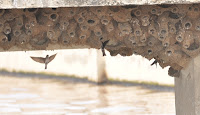Location: Bidarakatte, Next to Savandurga, Near Bangalore
Date: Oct 11th, 2020
To get there: [Click here for Google Map]. Take Mysore road towards Ramanagaram. Take a right from Ramanagara bus station and head straight for around 40 minutes. Take a right under the arch saying - Kempegowda Vanadhama Savanadurga to reach the Ramanagar division forest department in about 5 minutes. Check Forest Dept directions also for any updated information and also for booking (250 Rs/person) the trek as only guided treks are allowed here. There is another shorter route through Manchinbele, which we took on our way back.
Distance: About 50 to 60km from Jayanagar, Bangalore
 |
Trekkers on the trail
|
Trail type: Around 3 to 4 km one way if you take the longer scenic path that our guide chose on the way to the destination point. Less than 2 km with a short cut which we took on the way back. About 80% of the trail is walking on rocky mountains or monoliths. For an experienced and well-balanced trekker, this will be a breeze. But for those of us on the wrong side of the age curve or with some balance fears, this trek will feel very adventurous even though danger is minimal. Regardless, one has to be a bit careful where the slope becomes steep. In a few places, it is easier to slide down on our butts unglamorously than walk down in style. I chose the former! Note that it can get quite treacherous with rain or even a drizzle. Rubber-soled shoes with a good grip are ideal footwear.

Facilities: Ramnagar is a big town to stock up on any essentials if you are leaving Bangalore too early. A lot of village shops can be found on the way. Trailhead has a Forest Dept office with parking, drinking water, and basic toilet facilities. Warning: Toilet is usable but not clean.
It had been a while since we had gone on any group
family trek close by. When a close friend suggested this half-day trek to get relief from the covid mandated incarceration, that drought finally came to an end.
Bidarakatte is one of a
set of eco trails that the Karnataka Forest Dept is managing and would be a first for us. Only small groups with guides are allowed on the trail with pre-booking. Our group of 6 was to start at 7.30 am.
Up early, too early, on the trek day, with packed breakfast, we managed to pile into their XUV, delayed by only 15 mins from the 5.30am departure time. Taking some short cut village roads on a very cloudy day with the threat of rain, we reached the destination pretty much on time. We found the guide ready along with 3 others who would make up the full party of 10 now.
 |
Waterfall
|
 |
| Endpoint of Savandurga Trek |
Masks on initially, we headed down an easy path to what appeared to be a man-made lake. Scenic with the Savandurga Monolithic rock face towering over it. We didn't linger long and doubled back to head out on the actual trail along the foothills of the rock face. Calls of Sunbirds, White-browed Bulbul, Coucal could be heard but any movement was absent. No doubt, the birds were smarter to stay warm wherever they were instead of flying around in the dreary weather like us, humans. We did spot the tail of what looked like a Malkoha but the bird itself was too well hidden among the leaves to make a positive ID.
Soon we came out onto massive rocky outcrops, with lots of small pools of water and cacti. Add in lush forest greenery in the ravines and the tall Sanvandurga monolith backdrop, the views were spectacular. Any angle was a keeper for a landscape photographer. Walking on the rocks is easy as long as you are careful and take it slow. We had to pass through remnants of a fort which was quite exciting and aesthetically very beautiful. As we walked along the broad ridges, we could see the valley below with several villages.
 |
| Temple at endpoint |
 |
| Indian Grey Mangoose |
We reached the old abandoned temple in around 2 to 3 hours, stopping only for views and photos. The temple area overlooks a heavily forested ravine and some fort ramparts. Lots of great places to sit and enjoy a picnic breakfast while getting stunning views any which way you turn. Bird watching was a little more fruitful here with Blue Rock Thrush, Rufous Treepie, Egyptian vulture, Peregrine Falcon, and a nice flyby of a Tawny Eagle. A pair of
Indian Grey Mangoose, scuttled along the edges giving curious glances at us.
 |
| Blue Rock Thrush |
After spending a relaxed hour here, eating, birdwatching, exploring, or just lying back and staring at the skies, we headed back with rain, thankfully, still playing truant. As our guide chose a shorter route, we were back at the parking lot within an hour.
Overall, it is a great hike, close to the city with clean thick, and healthy forests. Add in the stunning views of rocks, pools, and fort ramparts, it is truly a gem. I sincerely hope the Karnataka Forest Dept maintains it the same way forever and with only guided treks.
As always, if you do choose to experience this trek, take only photos and leave only your footprints. I mean don't litter or damage the pristine environment.
 |
| Tawny Eagle |
Some more photos are
here.
Ebird Checklist for the avian curious. As noted before we did miss a Malkoha and I think one other raptor and probably a few others whose calls we heard but could not ID.




















